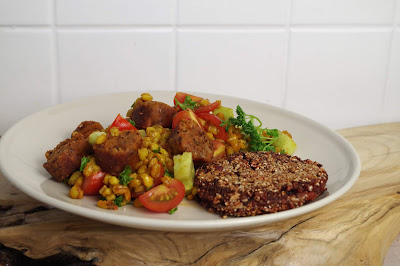 Meat substitute in Icelandic
Meat substitute in Icelandic
A typical Icelandic product that has long been replaced by imported products such as rice and pasta, but is now experiencing a renaissance (even in more sophisticated cuisine), is pearl barley, known as "bankabygg" in Icelandic. In contrast to rice and pasta, barley is grown in Iceland itself and is therefore a regional product that does not have to be imported in a laborious or expensive manner.
In connection with pearl barley, I recently came across Icelandic meat substitute products for vegetarians and vegans, namely vegetarian "sausages" and "Grænmetisbuff", i.e. vegetable burgers. Both products are made from barley pearls. Pearl barley has long been traditionally used in the production of sausages in Iceland, usually in addition to meat, not instead of meat. But why not try new things? Because I'm a curious person, I tried both out right away!
The name "Bulsur" is a play on words from "bygg" (= barley) and "pylsur" (= sausage). The "Bulsur" from the Havarí company consist of barley, kidney beans, water, tomato puree, cornmeal, flour, seeds, oil, salt and other spices. In Iceland you buy them frozen in packs of four, for example in Krónan, Nettó or Hagkaup. For my 300 g pack in the Krónan Granda I have just under 900 ISK (the equivalent of around €6.60 / as of March 2019).
The "Bulsur" are packed in a plastic wrapper, you have to remove the packaging from the individual "sausages" before putting them in the pan or on the grill.
The “vegetable burgers” from Móðir Jörð in Vallanes are available in two versions, one with barley and another with beetroot. I chose the beetroot version ("Rauðrófubuff"), a pack (250 g) with 4 citizens cost just under 800 ISK (approx. €5.90). Here, too, the product consists of over 40% barley, plus potatoes and beetroot (23%) as well as herbs and spices. The "breading" consists of pearl barley and sesame seeds, which gives the whole thing a nice, crunchy consistency on the outside.
The “vegetable burgers” are heated in a pan or in the oven.
In terms of taste, I actually found both tasty - for my taste, the "Bulsur" had a consistency that reminded me less of sausages and more of dumplings, soft and almost a bit creamy, but they tasted nice and spicy with the fried surface it's a bit crunchy again. Because of the breading, I found the "Rauðrófubuff" to be very crunchy on the outside and soft on the inside, but not too soft, still a little bit chunky... definitely very tasty!
I prepared both for lunch, the fried burgers and a pearl barley salad with fried bulsur. I'll definitely pass the recipe on to you in the next few days!
[Translated from
here.]
 200 g barley pearls
200 g barley pearls






















































